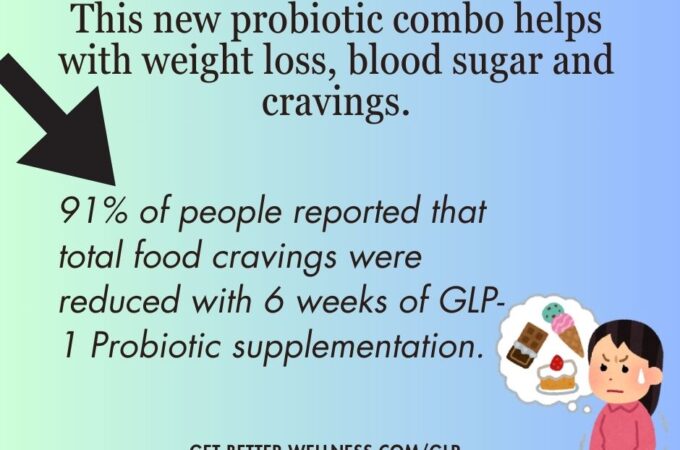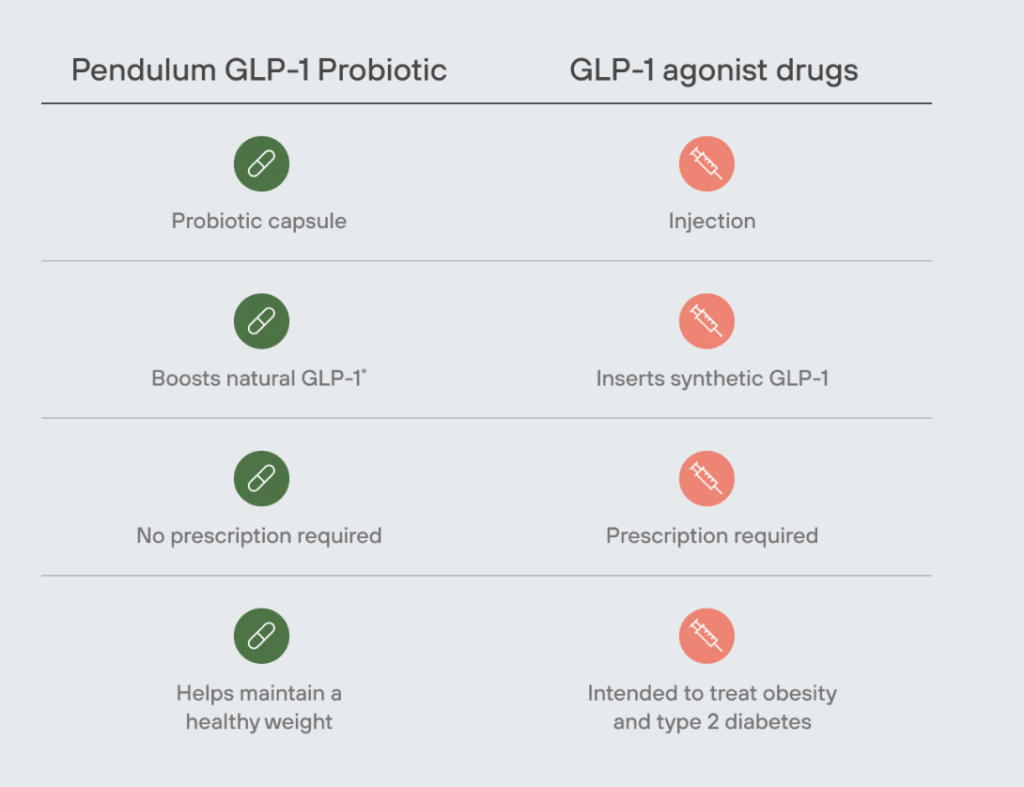
Probiotic Naturally Stimulates GLP-1 Production and Curbs Cravings
Maybe you have not heard of GLP-1 but you most likely are familiar with the popular weight loss drugs like Ozempic, Rybelsus and Wegovy, known as GLP-1 agonists. An agonist is a chemical that can bind and activate a receptor in the body.
Glucagon-like peptide-1 (GLP-1) is a peptide hormone produced and secreted by cells in the intestinal tract.
This Probiotic NATURALLY CURBS CRAVINGS
There is a multi-strain probiotic formulated with beneficial bacteria that naturally increase GLP-1, the “un-hunger” hormone that helps curb cravings & appetite.
In a six week study, participants took one probiotic pill daily. 91% reported reduced overall food cravings
- GLP-1 Probiotic helps maintain a healthy weight
- GLP-1 Probiotic enhances natural GLP-1 production
See the Five Step Protocol below to get the best results.
GLP-1 is essential for appetite regulation
- Your gut naturally produces GLP-1, the “un-hunger” hormone that plays multiple roles in metabolic health.
- Our body makes GLP-1 when we eat food. The hormone signals the brain that we are full.
- People who produce less GLP-1 naturally get more cravings and eat more.
- Unfortunately, GLP-1 can decrease with age and lifestyle.
- Now you can boost this powerful hormone with a targeted, science-backed strains that help you produce more GLP-1 naturally.
The health of your gut microbes may be determining how easily you control weight, blood sugar and cravings.
Your microbiome plays a role in how well GLP-1 works. Without the right bacteria, you will be experiencing more cravings.
- Our gut microbes play a role in various metabolic functions, including energy homeostasis, glucose metabolism, gut barrier, and endocrine functions. [source]
- Fecal transplant studies have shown that weight can be regulated by improving the gut microbes.[source]

Akkermansia is an important probiotic strain that plays a role in boosting GLP-1 Production
GLP-1 Probiotic naturally boosts GLP-1 production. It does not contain GLP-1 and is not a GLP-1 agonist drug.

Glucagon-like peptide-1 (GLP-1) is a peptide hormone produced and secreted by cells in the intestinal tract.
Like a key fitting into a lock (receptor), GLP-1 It binds to a specific GLP-1 receptor, which is expressed in various tissues, including cells and ducts of the pancreas, stomach lining, kidney, lung, heart, skin, immune cells, and the hypothalamus.
GLP-1 causes the release of insulin from the pancreas. It also slows gastric emptying, inhibit the inappropriate release on the hormone, glucagon, which raises glucose and fatty acids in the bloodstream. GLP-1 can result in reduced food intake.[source]
Two Probiotic Strains have been shown to Increase GLP-1 Naturally
Akkermansia and Clostridium butyricum increase GLP-1 naturally based on preclinical studies
When the probiotic Akkermansia muciniphila is present it has a beneficial effect on diseases such as inflammatory bowel disease (IBD), obesity, and diabetes.
Now Available: A Probiotic Blend that improves gut health and stimulated GLP-1 Production
Formulated with three strains that work together: Akkermansia muciniphila, Clostridium butyricum, and Bifidobacterium infantis
Akkermansia muciniphila generates the postbiotics propionate and p9 which induce GLP-1 production.
- Akkermansia is a next-generation beneficial strain that is essential for gut health.
- Pendulum Akkermansia holds a patented strain of Akkermansia muciniphila. It serves as one of the unique strains discovered through high-resolution DNA sequencing.
- Pendulum Akkermansia has been linked to helping with improved gut health.*
- Akkermansia is found in 1,000+ science publications and is known as the next generation strain at the forefront of gut health.
Clostridium butyricum produces the postbiotic butyrate which stimulates GLP-1 production. This specific microbe has the ability to convert dietary fiber into butyrate.
Low butyrate production has been associated with IBS, Impaired immune health, IBD, Celiac disease and metabolic syndrome.
Bifidobacterium infantis is a gut bacteria with many functions in the body. It is the key strain in the developing infant gut and immune system. It produces the Short Chain Fatty Acids acetate and lactate which feed bacteria such as Akkermansia and Butyricum, promoting an ecosystem in the gut that supports a healthy gut lining and naturally boosts GLP-1.
Customer Testimonials

Suggested Use:
Adults take 1 capsule daily with food, or as recommended by your healthcare professional.
Serving Size: 1 Capsule
Amount Per Serving
Probiotic Blend (500 million AFU) … 20mg
Clostridium butyricum WB-STR-0006
Akkermansia muciniphila WB-STR-0001
Bifidobacterium infantis
Chicory Inulin … 211mg
Other Ingredients: microcrystalline cellulose, hypromellose (vegetarian capsule), silica
Akkermansia is associated with reduced risk of obesity and reduced food cravings.
Total food cravings were reduced with 6 weeks of probiotic supplementation in 91% of people, based on a survey of 274 people.
Five Step Protocol: Support GLP-1 Production
- Probiotics. Supplement with Akkermansia muciniphila, Clostridium butyricum, and Bifidobacterium infantis. Consistent use is important when shifting the microbiome.
2. Prebiotic fiber foods
Encourage intake of prebiotic dietary fibers such as onion, chicory, garlic, asparagus, banana, and artichokes.
3. Polyphenols
Encourage intake of polyphenols such as pomegranate, green tea, and grape seed to increase Akkermansia muciniphila levels. If necessary, recommend polyphenol supplementation to further enhance the benefits.
Polyphenol Booster: Green Tea Extract, Pomegranate Extract, Vitis Vinifera, Anthocyanidins, Ellagic Acid
4. Omega-3 fatty acids
Consider supplementation with DHA/EPA to promote Akkermansia muciniphila abundance.
5. Nutrition
Eat a real food diet with sufficient amimal protein and fat to trigger satiety. Get my book, The Reclaim Diet.
What to Expect

Get Better Wellness is reader supported. This post may contain affiliate links, which means that I may receive a small commission when you buy from links on this site. This is at no cost to you.
Recommended
-
Dandelion for Liver Support and Health BenefitsJuly 20th, 2024
-
Modified Citrus PectinJuly 11th, 2024
-
Bentonite Clay Mask for Face and ArmpitsJuly 8th, 2024
-
Two Supplements for Erectile DysfunctionJune 30th, 2024









